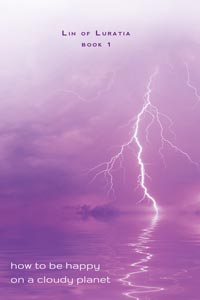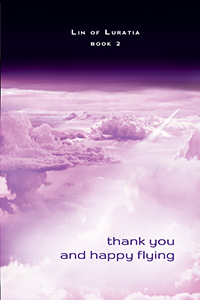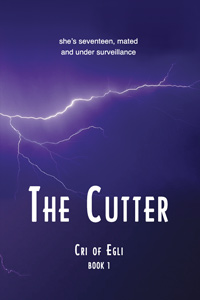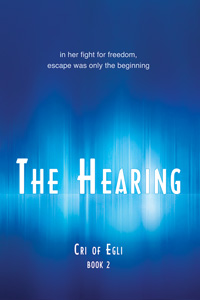about
The Planet Luratia
Lin of Luratia in her own words
The Trilogy Lin of Luratia
The YA Dystopian Series Cri of Egli
Graphene (aka clarkon)
Nanotechnology
Melanie Pahlmann in her own words

The Planet Luratia
Luratia is a world of clouds and lightning and the Nano Age wonders of space tourism, virtual reality videophones, and free wireless electricity.
Because it's a cloudy planet, and thus highly vulnerable to greenhouse gas effects, Luratians never strayed very long in their use and development of polluting sources of energy. They took a liking to wind power, tidal power, nuclear, and geothermal. But in the end, they settled on solar.
Solar power on a cloudy planet? The secret is space. Massive solar cell platforms hover in near-orbit and harmlessly beam electricity to the ground, where it is wirelessly distributed around the world. There is such an abundance of wireless electricity, it is virtually impossible to meter, thus it is free to anyone with a proper receiving device. Modern-era gadgets are powered anywhere, everywhere, all the time, without cords or batteries.
The technological landscape of Luratia is modeled in the likeness of our own near future so as to capture a realistic vision of the world and people we are growing into. As Earth soon will, Luratia is roiling in the wonders and hazards of its Nano Age—an era of microscopic machines, intelligent matter, retina-display virtual-reality smart phones, space elevators, bionic eyes and limbs, and ubiquitous video surveillance. It is an age into which Earth is quickly entering, eyes closed, for better and for worse.
Learn more about Luratia.
back to menu top of page

Lin of Luratia in her own words
I am Lin di Ana of the planet Luratia, a warm and cloudy planet 380 light years from Earth near the double star Albereo.
I have been granted permission to make communications to the people of Earth in the early 21st century. Using the technique of near-superluminal transport, nanoenergy packets are sent from my holographic videophone to the communication grid known as Earth’s World Wide Web.
The first of these communications began in my late teens, when I first discovered Earth in my Planetary Encyclopedia. Of all the inhabited worlds in this sector of the Milky Way Galaxy, I found Earth the most fascinating — so blue, so beautiful, so young and troubled. Terribly troubled, just like I was.
Why don’t you know about us? That’s the question I would ask. Most of the inhabited worlds know of each other, but a few planets — Earth among them — have not yet evolved the ability to receive, as would a radio, the higher frequencies of universe intelligence that endlessly pervade time and space. This is why you don’t yet know that you are a part of a growing stellar neighborhood of evolving inhabited worlds.
We live in an intelligently populated universe. And, despite your alien myths, it’s a friendly universe — annoyingly imperfect, too-slowly evolving (if you ask me), but friendly.
Learn more about Luratia.
back to menu top of page
The Trilogy Lin of Luratia
A coming-of-age solarpunk trilogy featuring nanotechnology, the wonder-material graphene, holographic smartphones, and a cloudy, solar-powered planet known as Luratia.
Book 1:
How to be Happy on a Cloudy Planet
When Lin and her schoolmates victoriously petition to modernize their primitive village with the Luratian equivalent of the Internet, a receiving tower goes up and the simple people of Bree are outfitted with holophones. Lin is certain that life for everyone will improve, but opposition is fierce, even within her own home. Disheartened but not daunted, Lin leads the fight for progress and learns that progress can be messy and win you enemies along the way.
softcover
more
Book 2: Thank You and Happy Flying
School's out in Bree, and everywhere you look is the standing dead — on the beaches and piers, in the martkeplace, out in the mosswoods. Even Lin is creeped out by the unsightly sight of her statue-like schoolmates, obliviously absorbed in virtual reality on their holophones. What choice do they have but be standing dead? Only half a step will shut off a holophone in Flight Mode. And virtual-reality flight is what they love most about their phones. With a simple command you can fly anywhere: over land, through a city, across an ocean, out into space. When an epidemic of holophone addiction breaks out across Bree, chaos erupts and Lin’s naysaying enemies conspire to destroy everything she’s worked for.
softcover
more
Book 3: Pure Sky Life
This is the day Lin dreamed of, the day she worked so hard for, the day her life begins — a big life of promise an ocean away from home. But when Lin touches down on the violet sands of Vona, catastrophe strikes. Through schemes and cunning, she takes on the challenge of repairing the damage while somehow finding her place in a new and strange culture all but her call home.
softcover
more
back to menu top of page
The YA Dystopian Series Cri of Egli
The Nano Age is a bad time to be a slave.
Cri is seventeen, mated and under surveillance. Born into Luratia's last slave race, she is the property of the Egli Mineral Resources Corporation. Since the age of four, she has been perpetually watched by a technique known as embedded surveillance — a carbon-based, nanotech tracking device delicately wrapped around the main artery of her neck. The device constantly monitors her location and records every word she speaks. It administers sound alerts to signal the start and finish of work shifts and meals. It meets out punishments by pinching the long and sensitive cattiva nerve.
Book 1:
The Cutter
Cri was born with an exceptional genetic profile and is one of the fortunate few in the Egli slave class who will rise in status from a Menial to a Breeder. Most girls envy Cri's Breeder status, but Cri has no interest in the privileged life it offers. She craves freedom and is willing to die for it. Now that her breeding obligations have come due, she can’t put off her escape any longer.
softcover
more
Book 2: The Hearing
In her fight for freedom, escape was only the beginning. They got out with their lives and crossed the Outer Edges, but Cri and Bul won’t know freedom until a Cutter removes the tracking nodules embedded in their necks. Injured and without food, they have to survive in the wild while evading detection by the surveillance drones that hunt them down.
softcover
more
Book 3: The Colony
Cri and Bul have escaped with their lives, and the Corporation has lost all ownership rights. Cri is a free woman. Bul is a free man. But before they can find a home in the world, they must serve two years in the Colony, a refugee camp for escaped slaves. Bul adjusts well to their life there, but for Cri, if feels more like a penal colony than a path to freedom. Is another escape her only solution?
softcover
more
Learn more about Cri and her world.
back to menu top of page
About Graphene (aka clarkon)
Graphene is a 2-dimensional material — one atom thick — the first of its kind. About a dozen 2D materials have been isolated as of early 2016, and this new class of material is remarkable. These and other interesting nanomaterials are about to radically change every aspect of the way we live. Our emerging Nano Age will outshine steel, plastic, and the silicon chip as transformative milestones in Earth's long evolutionary adventure.
 Graphene is a one-atom-thick layer of graphite, commonly known as pencil lead, which is formed entirely of carbon atoms. These carbon atoms are densely packed in a honeycomb lattice. The bond these carbon atoms form is incredibly strong and impermeable. If you layer sheets and sheets of graphene, you have a substance like steel that is 200 times lighter in weight and 2000 times stronger. This makes graphene an excellent material for vehicles and buildings.
Graphene is a one-atom-thick layer of graphite, commonly known as pencil lead, which is formed entirely of carbon atoms. These carbon atoms are densely packed in a honeycomb lattice. The bond these carbon atoms form is incredibly strong and impermeable. If you layer sheets and sheets of graphene, you have a substance like steel that is 200 times lighter in weight and 2000 times stronger. This makes graphene an excellent material for vehicles and buildings.
Graphene is elastic, superconductive, anti-bacterial, impermeable, and invisible. Graphene will be used to make:
- bendable cell phones with unbreakable touchscreens
- ultra-efficient cell phone chargers that charge a phone in 5 seconds
- water filters you can carry in your pocket that will clean the dirtiest water
- high-fi ear buds, comparable in quality to a pair of Bose speakers
- super-quick uploads, a terabit in one second
- transparent computer displays super-thin screens of any size that can be rolled up and easily transported
- bionic devices that can be embedded in living tissue and connected to the brain, a development that will help people with spinal injuries regain use of their limbs
- sensors that can diagnose diseases accurately and non-invasively
- sidewalks and buildings that eat up air pollution
- food packaging that tells you when the food inside is spoiled
Learn more about graphene and nanotechnology.
back to menu top of page
About Nanotechnology
Nano means "one-billionth"—a nanometer is one-billionth of a meter—and since atoms and molecules are measured in the billionths of meters, nanotechnology can be thought of as atomic and molecular-scale science. A nanobot is a robot smaller than a blood cell, which allows it to easily navigate the bloodstream. Remarkable advancements are being made in medical uses of nanotechnology, such as delivering cancer-destroying nanobots to precise locations in the body and making artificial organs using a person's own tissue cells.
Nanotechnology is a rapidly evolving science that encompasses biology, chemistry, robotics, electronics, semiconductor physics, medicine, and environmental sciences.
Learn more about nanotechnology.
back to menu top of page
About Melanie Pahlmann in her own words
Despite the dystopian futures that haunt our storytelling, I believe that Earth's best years are ahead of us. Some might call this view utopian,
but I disagree. Decency, kindness, and maturity are what it will take to make a better future, and these aren't impossible achievements, not for a person and not for a world.
I’ve never believed that we're alone in the universe, and
as I look at the stars at night I always wonder which ones are the suns of planets peopled with creatures not unlike us, creatures who love and laugh and feel sadness and want to be happy. I’ve looked up and wondered what everyday life might be like on a nearby world. I wondered so much, a girl was born in my mind—Lin—a hyper-adventurous girl, bright and curious, destined to become a great person in the annals of her planet’s history. Like many great people, she would come from humble and difficult origins, born with an extraordinary something that sets her apart from the rest and makes her life less than easy, normal, contented, or ever satisfied.
Later Cri was born in my mind. She too comes from difficult beginnings—she's a modern-age slave—and lives with a consuming drive to ascend her misfortune of birth, to escape and live a life of freedom.
My Lin of Luratia fiction trilogy explores what happens when small town values meets the promises and perils of high technology. The young adult adventure series Cri of Egli takes a realistic look at how ubiquitous surveillance techniques will soon shape our lives, for better and for worse. Much of what I write about is based on current research conducted by the Center for Nanotechnology in Society at Arizona State University.
My first year selling books at the Ajo Mercado Art & Book Fair.
I had just completed the Lin of Luratia trilogy.

My third year selling books at the Mercado.
The final book of the Cri of Egli trilogy was just about done.

In subsequent years I designed and published my Ajo Dark Sky Calendars, which were very popular not only in Ajo but in other parts of the Northern Hemisphere.


back to menu top of page






 Graphene is a one-atom-thick layer of graphite, commonly known as pencil lead, which is formed entirely of carbon atoms. These carbon atoms are densely packed in a honeycomb lattice. The bond these carbon atoms form is incredibly strong and impermeable. If you layer sheets and sheets of graphene, you have a substance like steel that is 200 times lighter in weight and 2000 times stronger. This makes graphene an excellent material for vehicles and buildings.
Graphene is a one-atom-thick layer of graphite, commonly known as pencil lead, which is formed entirely of carbon atoms. These carbon atoms are densely packed in a honeycomb lattice. The bond these carbon atoms form is incredibly strong and impermeable. If you layer sheets and sheets of graphene, you have a substance like steel that is 200 times lighter in weight and 2000 times stronger. This makes graphene an excellent material for vehicles and buildings.



